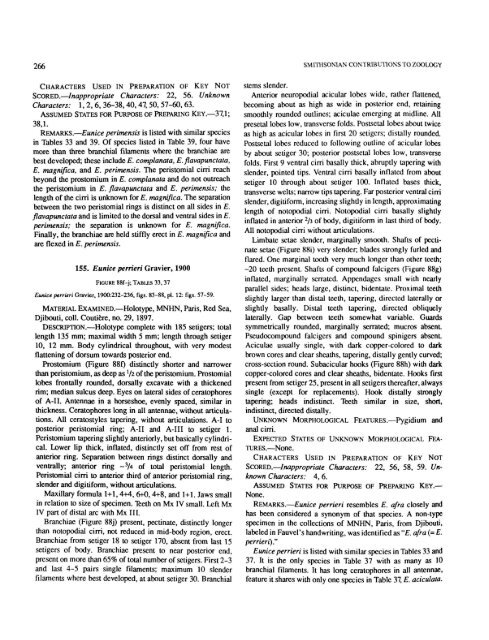A Review of the Genus Eunice - Smithsonian Institution Libraries
A Review of the Genus Eunice - Smithsonian Institution Libraries
A Review of the Genus Eunice - Smithsonian Institution Libraries
You also want an ePaper? Increase the reach of your titles
YUMPU automatically turns print PDFs into web optimized ePapers that Google loves.
266 SMITHSONIAN CONTRIBUTIONS TO ZOOLOGY<br />
CHARACTERS USED IN PREPARATION OF KEY NOT<br />
SCORED.—Inappropriate Characters: 22, 56. Unknown<br />
Characters: 1, 2, 6, 36-38,40,47, 50, 57-60,63.<br />
ASSUMED STATES FOR PURPOSE OF PREPARING KEY.—37,1;<br />
38,1.<br />
REMARKS.—<strong>Eunice</strong> perimensis is listed with similar species<br />
in Tables 33 and 39. Of species listed in Table 39, four have<br />
more than three branchial filaments where <strong>the</strong> branchiae are<br />
best developed; <strong>the</strong>se include E. complanata, E.flavapunctata,<br />
E. magnifica, and E. perimensis. The peristomial cirri reach<br />
beyond <strong>the</strong> prostomium in E. complanata and do not outreach<br />
<strong>the</strong> peristomium in E. flavapunctata and E. perimensis; <strong>the</strong><br />
length <strong>of</strong> <strong>the</strong> cirri is unknown for E. magnifica. The separation<br />
between <strong>the</strong> two peristomial rings is distinct on all sides in E.<br />
flavapunctata and is limited to <strong>the</strong> dorsal and ventral sides in E.<br />
perimensis; <strong>the</strong> separation is unknown for E. magnifica.<br />
Finally, <strong>the</strong> branchiae are held stiffly erect in E. magnifica and<br />
are flexed in E. perimensis.<br />
155. <strong>Eunice</strong> perrieri Gravier, 1900<br />
FIGURE 88f-j; TABLES 33,37<br />
<strong>Eunice</strong> perrieri Gravier, 1900:232-236, figs. 83-88. pi. 12: figs. 57-59.<br />
MATERIAL EXAMINED.—Holotype, MNHN, Paris, Red Sea,<br />
Djibouti, coll. Coutiere, no. 29, 1897.<br />
DESCRIPTION.—Holotype complete with 185 setigers; total<br />
length 135 mm; maximal width 5 mm; length through setiger<br />
10, 12 mm. Body cylindrical throughout, with very modest<br />
flattening <strong>of</strong> dorsum towards posterior end.<br />
Prostomium (Figure 88f) distinctly shorter and narrower<br />
than peristomium, as deep as 1 /2 <strong>of</strong> <strong>the</strong> peristomium. Prostomial<br />
lobes frontally rounded, dorsally excavate with a thickened<br />
rim; median sulcus deep. Eyes on lateral sides <strong>of</strong> ceratophores<br />
<strong>of</strong> A-II. Antennae in a horseshoe, evenly spaced, similar in<br />
thickness. Ceratophores long in all antennae, without articulations.<br />
All ceratostyles tapering, without articulations. A-I to<br />
posterior peristomial ring; A-II and A-III to setiger 1.<br />
Peristomium tapering slightly anteriorly, but basically cylindrical.<br />
Lower lip thick, inflated, distinctly set <strong>of</strong>f from rest <strong>of</strong><br />
anterior ring. Separation between rings distinct dorsally and<br />
ventrally; anterior ring - 3 A <strong>of</strong> total peristomial length.<br />
Peristomial cirri to anterior third <strong>of</strong> anterior peristomial ring,<br />
slender and digitiform, without articulations.<br />
Maxillary formula 1+1,4+4, 6+0,4+8, and 1+1. Jaws small<br />
in relation to size <strong>of</strong> specimen. Teeth on Mx IV small. Left Mx<br />
IV part <strong>of</strong> distal arc with Mx III.<br />
Branchiae (Figure 88j) present, pectinate, distinctly longer<br />
than notopodial cirri, not reduced in mid-body region, erect.<br />
Branchiae from setiger 18 to setiger 170, absent from last 15<br />
setigers <strong>of</strong> body. Branchiae present to near posterior end,<br />
present on more than 65% <strong>of</strong> total number <strong>of</strong> setigers. First 2-3<br />
and last 4-5 pairs single filaments; maximum 10 slender<br />
filaments where best developed, at about setiger 30. Branchial<br />
stems slender.<br />
Anterior neuropodial acicular lobes wide, ra<strong>the</strong>r flattened,<br />
becoming about as high as wide in posterior end, retaining<br />
smoothly rounded outlines; aciculae emerging at midline. All<br />
presetal lobes low, transverse folds. Postsetal lobes about twice<br />
as high as acicular lobes in first 20 setigers; distally rounded.<br />
Postsetal lobes reduced to following outline <strong>of</strong> acicular lobes<br />
by about setiger 30; posterior postsetal lobes low, transverse<br />
folds. First 9 ventral cirri basally thick, abruptly tapering with<br />
slender, pointed tips. Ventral cirri basally inflated from about<br />
setiger 10 through about setiger 100. Inflated bases thick,<br />
transverse welts; narrow tips tapering. Far posterior ventral cirri<br />
slender, digitiform, increasing slightly in length, approximating<br />
length <strong>of</strong> notopodial cirri. Notopodial cirri basally slightly<br />
inflated in anterior 2 /3 <strong>of</strong> body, digitiform in last third <strong>of</strong> body.<br />
All notopodial cirri without articulations.<br />
Limbatc setae slender, marginally smooth. Shafts <strong>of</strong> pectinate<br />
setae (Figure 88i) very slender, blades strongly furled and<br />
flared. One marginal tooth very much longer than o<strong>the</strong>r teeth;<br />
-20 teeth present. Shafts <strong>of</strong> compound falcigcrs (Figure 88g)<br />
inflated, marginally serrated. Appendages small wilh nearly<br />
parallel sides; heads large, distinct, bidentatc. Proximal teeth<br />
slightly larger than distal teeth, tapering, directed laterally or<br />
slightly basally. Distal teeth tapering, directed obliquely<br />
laterally. Gap between teeth somewhat variable. Guards<br />
symmetrically rounded, marginally serrated; mucros absent.<br />
Pseudocompound falcigers and compound spinigcrs absent.<br />
Aciculae usually single, wilh dark copper-colored to dark<br />
brown cores and clear sheaths, tapering, distally gently curved;<br />
cross-section round. Subacicular hooks (Figure 88h) with dark<br />
copper-colored cores and clear sheaths, bidentate. Hooks first<br />
present from setiger 25, present in all setigers <strong>the</strong>reafter, always<br />
single (except for replacements). Hook distally strongly<br />
tapering; heads indistinct. Teeth similar in size, short,<br />
indistinct, directed distally.<br />
UNKNOWN MORPHOLOGICAL FEATURES.—Pygidium and<br />
anal cirri.<br />
EXPECTED STATES OF UNKNOWN MORPHOLOGICAL FEA-<br />
TURES.—None.<br />
CHARACTERS USED IN PREPARATION OF KEY NOT<br />
SCORED.—Inappropriate Characters: 22, 56, 58, 59. Unknown<br />
Characters: 4,6.<br />
ASSUMED STATES FOR PURPOSE OF PREPARING KEY.—<br />
None.<br />
REMARKS.—<strong>Eunice</strong> perrieri resembles E. afra closely and<br />
has been considered a synonym <strong>of</strong> that species. A non-type<br />
specimen in <strong>the</strong> collections <strong>of</strong> MNHN, Paris, from Djibouti,<br />
labeled in Fauvel's handwriting, was identified as "£. afra (= E.<br />
perrieri)."<br />
<strong>Eunice</strong> perrieri is listed with similar species in Tables 33 and<br />
37. It is <strong>the</strong> only species in Table 37 with as many as 10<br />
branchial filaments. It has long ceratophores in all antennae,<br />
feature it shares with only one species in Table 37, E. aciculata.
















